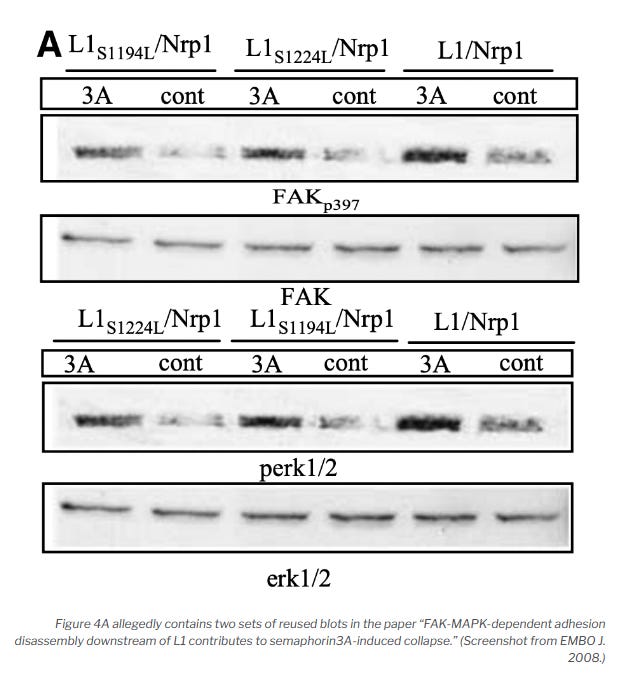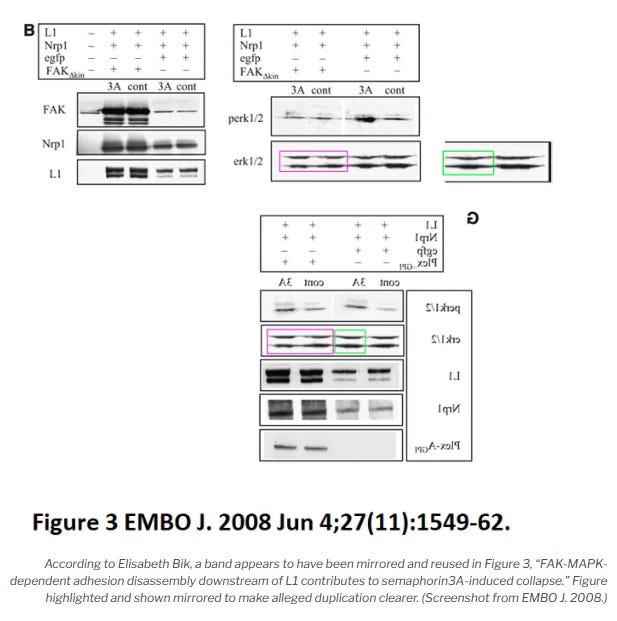Stanford Scandal
18-year-old makes Stanford's President resign
Manipulating science at Stanford
I think the recent Harvard scandal has been overshadowed by this Stanford scandal.
Marc Tessier-Lavigne resigned as the president of Stanford University due to an investigation into his research.
Below is 1 example of image manipulation found in one of Marc's articles.
This may sound like another story of academic fraud, that's not the case.
Pete did share another great video…
But there is more to the story.
Research history
Marc was, and remains, a researcher in neuroscience.
Back in 2009 he did some research with the Genentech biotechnology company.
Allegations of fraud followed that work.
Marc was found innocent of any wrong doing.
But in 2010, a similar situation led to a postdoc termination, and the manuscript being withdrawn.
Another situation, a little different, had Dr. Tessier-Lavigne stating that other writing corrections would be addressed.
But he didn't contact the journal, or attempt to issue an erratum (list of corrected errors).
The future report, (explored later in this article) found corrections from 2016 still to be issued.
To date, the scientific record remains uncorrected
In 2015, while Marc was being considered for the president role at Stanford University, Marc was made aware of another paper with several errors.
Marc might have opened up a new field of research into a molecule required for guiding axons connecting neurons to the brain.
But how much of that science can be trusted?
Independent Investigators
Helped by his peers and other experienced investigators like Elisabeth Bik.
Theo Baker, an 18-year-old first year, shared his findings on the Stanford University blog.
Elisabeth has investigated 20,000+ papers for research misconduct, causing nearly 1,000 retractions alone.
In this case, she mentions type 1 and type 3 errors.
A type 1 error is most common, often accidental errors being made.
Using the same photo maybe...
However, a type 3 error is far more intentional.
Image alteration, like rotating an image or photoshopping parts.
Not taking Elisabeth’s word, Stanford did their own, 8 month long investigation.
It was run by former federal judge, Mark Filip, and his law firm Kirkland & Ellis.
The report
12 papers were investigated, 5 of them with Marc as the primary author.
Despite the report concluding, it couldn't find evidence Marc himself had done any manipulation, or he knew about any manipulation at the time.
Out of the 5 Marc authored, 3 papers were retracted and 2 needed corrections.
This database suggests 4 in every 1000 papers are retracted.
The report stating:
unusual frequency of manipulation of research data and/or substandard scientific practices
Which seems to have spread over 3 institutions dating back 20+ years.
During the investigation, someone with an $18 million investment in one of Marc's companies was found to be part of the investigation.
A conflict of interest, you might think.
But, remarkable to me was that these allegations were not new!
PubPeer had various forums discussing these issues going right back to the 2009 case.
This report shows a history of:
Poor research integrity.
Questionable research behaviour.
Low scientific practices.
All of which required an 18-year-old reporter and expert investigators to get Stanford to act.
Ongoing situation
Marc earned $1,555,296 from Stanford in 2021, with an additional $700,000 annually for being on the board of directors.
He has resigned as president, as of the 31st August 2023.
But is still able to lecture, research, and remain on the board into the next academic year.
Unlike Francesca Gino, Marc Tessier-Lavigne is still earning, and to my knowledge is not filing any lawsuit.
What exactly was the punishment for the decades of malpractice?
The wider story
Fake science is out there.
Retraction watch shares stories similar to this almost daily.
But Stanford University is where I would put the microscope.
How does someone with so many question marks become the president?
This goes beyond Marc, and into the institution.
But that is what I'm learning about.



